

I’LL BE DAMNED!
VAMPYR (1932)
David Gray checks in to a creepy hotel. The titles tell us he is a dreamy young man who has studied the occult.He checks into his room & goes to bed. An old man enters his room and warns him that "she must not die." He leaves a package "to be opened after my death." Gray gets out of bed and experiences a series of strange events. He sees shadows of a man with a peg leg (the shadow finds its owner and rejoins it). He meets an old man with a mustache who asks, "do you hear that?". Gray replies that he hears children and dogs. The old man tells him with a sinister stare that there are no children or dogs here.
The man with the package gets shot at this point. Gray runs to help and meets the rest of the inhabitants of the hotel. It turns out that the man with the mustache is a doctor, and that one of the young daughters of the hotel owner is sick with some strange malady. Gray opens his package, which turns out to be a book about vampires. Vampire mythology was less well known to audiences than now, and Dreyer uses exposition pages from the book.Gray dreams he leaves his body sitting on a bench, then finds himself in a coffin with a window in it. He wakes up and realizes that the wife of the doctor is really a vampire. Gray helps drive a stake into her heart and she turns into a skeleton. The doctor runs into a flour mill and is buried under a pile of flour. And David Gray floats away on a boat with the pretty sister of the afflicted girl.
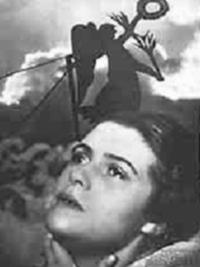
Notable is Dreyer's only use ever of superimposition, to create shadows & transparent spirits to reinforce the strangeness. The sound track is quite successful too, with eerie music and strange noises which serve as characters' voices, from the canine growls of the old villain to the distant, unearthly tones of David Gray's love. Poignantly, the hoarse voice of the possessed girl alters at the moment of her final liberation to the pure high pitch of the ethereal heroine.
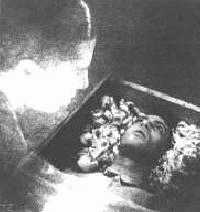
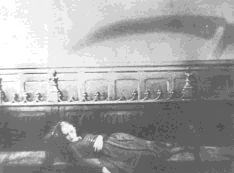
the most beautiful horror movie of all time. It is a mystery;initially percieved as a succession of images, the plot comes together gradually on reflection.
It is trance-film, the prototype of which is Caligari;a passive hero experiences events which are primarily manifestations of the unconscious. Things happen to the characters; they don't initiate actions (which on initial viewing seem unrelated). The characters' movements are automatic and fated, voices hollow & distant, suggesting disembodied spirits. There is little talking. Dialogue like "the wounds have almost healed" and "why does the doctor only come at night" are given without explanation.
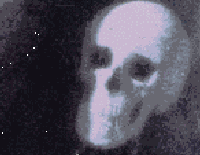
The action is treated matter-of-factly even when bizarre, the point of view literal and realistic. There seems to be a traditionally coherent story, with the implicit promise that all may be explained. But it never is. Causal connections between events are deviously lacking. Logic is undermined, and the subversion of "reality" reaches its climax toward the end, when the scene of David Gray finding the bound heroine is repeated exactly, a visual echo and more, the very ghost of event.
An early image of a reaper and scythe in silhouette graphically establishes Vampyr's preoccupations. Even when the hero & heroine get across the Stygian waters, the picture doesn’t appreciably brighten. But youth and love do survive and escape age &death. And death has its salubrious side. It is a deliverance for the Count &the bedridden girl, animated as they are by evil spirits. But unnatural and horrible for the hero, David Gray, as he is borne, alive and healthy, but trancefixed, in a coffin toward his grave.
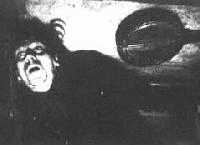
Cinematographer Maté also worked with Dreyer on The Passion of Joan of Arc and, after Vampyr, moved on to Hollywood .He went on to direct the great Hollywood film noir D.O.A. (1950),producing an outstanding body of work, but he was never allowed to experiment again like he did with Dreyer. The work he did in "Vampyr" was one of a kind.
Vampyr is also known as The Strange Adventures of David Gray, Not Against the Flesh, Traum des David Gray, and Castle of Doom. from-Ken Kelman, Great Film Directors. (originally appeared in Film Culture, Winter 1964-65).
Director: Carl Theodor Dreyer.Producers: Carl Theodor Dreyer,Baron Nicolas de Gunsburg.Screenplay: Carl Theodor Dreyer, Christen Jul, Photography: Rudolph Mate, Louis Nee.Editor: Carl Theodor Dreyer .Music: Wolfgang Zeller Players:Julian West [Baron Nicolas de Gunsberg] (David Gray).Henriette Gerard (Marguerite Chopin).Sybille Schmitz (Leone),Renee Mandel (Gisele),Maurice Schutz (Lord of the Manor),Jan Hieronimko (Doctor),Jane Mora (Nurse).71 mins.
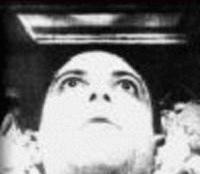
Roy Frumkes created DOCUMENT to hear, in Romero's own words, how he creates a movie,& to shoot what Frumkes (a teacher at the N.Y. School of Visual Arts) described as a "kinetic lesson on the set of a film in production." Since his crew was comprised primarily of students, Roy had to find non-union, independent films to cover. He wisely chose a sequel to a popular horror film of the 60’s, DAWN OF THE DEAD (1978). This was long before the endless stream of "Making Of..." specials catering mainly to special-effects fans. DOCUMENT details the process of constructing & distributing an independent feature. The work of make-up wizard TOM SAVINI is not glossed over; there's a high-speed sequence of Tom gluing appliances and pouring blood on Frumkes himself. It's nostalgic to hear Tom say, "No, [there are no makeup schools] that I know of...I had to teach myself." ROMERO is an unsung hero in independent film, especially the low and no-budget horror world. His taboo-breaking tale of zombie flesh-eaters , NIGHT OF THE LIVING DEAD (1968), may have looked grainy & uneven, but audiences had a strong, visceral reaction to the sight of ghouls gobbling up entrails. It wasn't just the gore which shook people up. It was the frenetic pace of the film, the sheer number of jarring cuts from one canted angle to the next, an alienating wide shot of a woman in the field shifting perspective into a hustling medium-shot as she runs along. The juxtaposition of disturbing close-ups on household objects with wide action shots of ever increasing ghouls on the lawn outside.
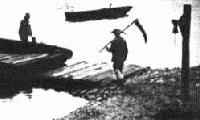
Winner of a Gold Award at the Houston International Film Festival.
BEST QUOTE: "I'd really like to be a zombie, George. I really would. I'd work hard. I'd shuffle. I'd bleed. Whatever you want me to do."
Dir/Scr/Prod. Roy Frumkes, Phot. Reeves Lehman. Mus. Ralf Ulfik. Anim. Henry Jones. Prod Co Roy Frumkes Productions. Feat: John Amplas, Carl Augenstein, Steve Bissette, David Emge, Ken Foree, Michael Gornick, Scott H. Reiniger, Christine Romero, GEORGE A. ROMERO, Richard P. Rubinstein, TOM SAVINI, Gahan Wilson. Narr: Susan Tyrrell. 66 mins. NFVLS.
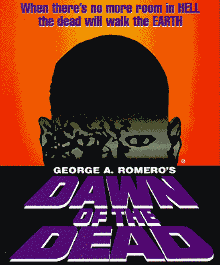
BACK TO THE VAULT
SPLODGE! HOMEPAGE